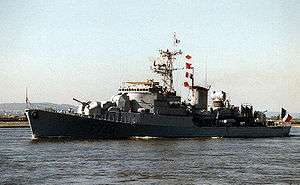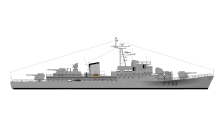Commandant Rivière-class frigate
The Commandant Rivière class was a class of frigates built for the French Navy in the late 1950s and early 1960s. Labeled "aviso-escorteur" (fr: "sloop-escort"), they were designed to perform the role of overseas patrol in peacetime and anti-submarine escort in wartime.[1] This vessel class is named after the French Navy officer Henri Rivière (naval officer) (1827 - 1883).
 Escort Commandant Bourdais on the Seine river in July 1989 | |
| Class overview | |
|---|---|
| Name: | Commandant Rivière class |
| Builders: | Arsenal de Lorient |
| Operators: | |
| Preceded by: | Le Normand class |
| Succeeded by: | D'Estienne d'Orves class |
| Subclasses: | João Belo class |
| In commission: | 1962–1991 |
| Completed: | 9 |
| Laid up: | 1 (Uruguay) |
| Retired: | 6 |
| General characteristics [1] | |
| Type: | Frigate |
| Displacement: | 1,750 tons standard, 2,230 tons full load |
| Length: | |
| Beam: | 11.5 m (37 ft 9 in) |
| Draught: | 4.3 m (14 ft 1 in) |
| Propulsion: |
|
| Speed: | 25 knots (46 km/h; 29 mph) |
| Range: | 7,500 nmi (13,900 km; 8,600 mi) at 16 knots (30 km/h; 18 mph) |
| Boats & landing craft carried: | 2 × LCP landing craft |
| Complement: | 166 |
| Sensors and processing systems: |
|
| Armament: |
|
Four similar ships were built for the Portuguese Navy as the João Belo class.[2]
Design

The main gun armament of the Commandant Rivière class consisted of three of the new French 100 mm (4 in) guns, with a single turret located forward and two turrets aft.[1][3] These water-cooled automatic dual-purpose guns could fire a 13.5 kg (30 lb) shell at an effective range of 12,000 m (39,000 ft) against surface targets and 6,000 m (20,000 ft) against aircraft at a rate of 60 rounds per minute. A quadruple 305 mm anti-submarine mortar was fitted in 'B' position, aft of the forward gun and in front of the ship's superstructure,[1] capable of firing a 230 kg (510 lb) depth charge to 3,000 m (9,800 ft) or in the shore bombardment role, a 100 kg (220 lb) projectile to 6,000 m (20,000 ft).[5] Two triple torpedo tubes were fitted for anti-submarine torpedoes, while the ship's armament was completed by two 30 mm Hotchkiss HS-30 cannon.[1] The ships had accommodation for an 80-man commando detachment with two fast landing boats, each capable of landing 25 men.[6]
While the previous French frigates of the Le Corse and Le Normand classes were powered by steam turbines,[7] because a long-range was required for the overseas colonial role of the ships, the class was instead fitted with a 16,000 bhp (12,000 kW) two-shaft diesel powerplant, capable of propelling the ship at a speed of 26 kn (30 mph; 48 km/h), although 26.6 kn (30.6 mph; 49.3 km/h) was reached during trials.[8][9]
Two ships of the class were fitted with modified power plants. Commandment Bory was powered by Free-piston engines driving gas turbines, although it was refitted with a conventional diesel installation in 1974–1975, while Balney was fitted with an experimental CODAG (Combined diesel and gas) installation, with a 11,500 hp (8,600 kW) and two 3,600 bhp (2,700 kW) diesel engines driving a single shaft. The CODAG arrangement took up less space, allowing 100 tons more fuel to be carried and giving a range of 13,000 nmi (15,000 mi; 24,000 km) at 10 kn (12 mph; 19 km/h). Balny omitted one 100 mm gun turret to accommodate the revised machinery.[6][10]
Operational history
The first of the class,[11] Victor Schoelcher entered service in October 1962, with all but one of the class following in the next 27 months. The exception was the CODAG powered Balny, which although launched in 1962 and completed in 1964, did not commission until 1970, being employed as a trials ship in the meantime.[1][10]
Commandant Bourdais was used for fishery protection in the North Atlantic from 1963 to 1972,[12][13] while several of the ships of the class were used as training ships, including Victor Schoelcher (1961–1973)[14] and Commandant Bourdais.[5] In the 1970s, all except Balny had one 100 mm turret replaced by four MM 38 Exocet anti-ship missile launchers, while several of the ships had their 30 mm cannon replaced by Bofors 40 mm guns.[6]
In 1984–1985, Commandant Rivière was converted to a sonar-trials ship. The ship's armament was replaced by a single 40 mm Bofors gun and two 12.7 mm machine guns, while the ship's stern was rebuilt to accommodate a hoist for a variable depth sonar, which was used to test various active and passive towed array sonars.[6][15]
All French units were decommissioned in the early-1990s, save for three frigates that were sold to the Uruguayan Navy.[1][16]
Ships
All French ships were built by Arsenal de Lorient
| Pennant | Name | Namesake | Laid Down[1] | Launched[1] | Commissioned[1] | Fate |
|---|---|---|---|---|---|---|
| F 733 | Commandant Rivière | Henri Rivière | April 1957 | 11 October 1958 | 4 December 1962 | Trials ship 1986 - decommissioned late 1990s |
| F725 | Victor Schoelcher | Victor Schoelcher | October 1957 | 11 October 1958 | 15 October 1962 | Sold to Uruguay 1988 as General Artigas[17] Decommissioned 27 April 2005.[18] |
| F726 | Commandant Bory | Victor Bory | May 1958 | 11 October 1958 | 5 March 1964 | Decommissioned 1 September 1996[19] |
| F727 | Amiral Charner | Léopold Victor Charner | November 1958 | 12 March 1960 | 14 December 1962 | Sold to Uruguay 1991 as Montevideo[17] |
| F740 | Commandant Bourdais | Adrien Bourdais | April 1959 | 15 April 1961 | 10 March 1963 | Sold to Uruguay 1990 as Uruguay[17] |
| F 728 | Doudart de Lagrée | Ernest Doudart de Lagrée | March 1960 | 15 April 1961 | 1 May 1963 | Decommissioned 1991 |
| F 729 | Balny | Adrien-Paul Balny d'Avricourt | March 1960 | 17 March 1962 | 1 February 1970 | Decommissioned 1994 |
| F 748 | Protet | Auguste Léopold Protet | September 1961 | 7 December 1962 | 1 May 1964 | Decommissioned 1992[20] |
| F 749 | Enseigne de Vaisseau Henry | Paul Henry | September 1962 | 14 December 1963 | 1 January 1965 | Decommissioned 1994 |
See also
- List of Escorteurs of the French Navy
Notes
- Gardiner and Chumbley 1995, p. 117.
- Gardiner and Chumbley 1995, p. 319.
- Blackman 1962, p. 88.
- Grove 1990, p. 55.
- Gardiner and Chumbley 1995, p. 118.
- Gardiner and Chumbley 1995, pp. 116–117.
- Gardiner and Chumbley 1995, pp. 117–118.
- Prézelin and Baker 1990, p. 158.
- Prézelin and Baker 1990, p. 157.
- The first to have been commissioned, but the second in her class, after Commandant Rivière, prototype and head of the series.
- Blackman 1971, p. 115.
- Lecouvey, Jean Paul (1997). "L'assistance à la grande pêche". netmarine.net (in French). Retrieved 21 June 2015.
- Roche, Jean-Michel. "Histoire de l'aviso-escorteur Victor Schoelcher (1958-1988)". netmarine.net (in French). Retrieved 21 June 2015.
- Prézelin and Baker 1990, p. 167.
- "Aviso-escorteur Commandant Rivière". netmarine.net (in French). Retrieved 21 June 2015.
- Baker 1998, p. 1142.
- "Aviso-escorteur Victor Schoelcher". netmarine.net (in French). Retrieved 21 June 2015.
- Baker 1998, p. 223.
- "Histoire de l'aviso-escorteur Protet (1981-2001)". netmarine.net (in French). Retrieved 21 June 2015.
References
- Baker, A. D. (1998). The Naval Institute Guide to Combat Fleets of the World 1998–1999. Annapolis, Maryland: Naval Institute Press. ISBN 1-55750-111-4.
- Blackman, Raymond V. B., ed. (1962). Jane's Fighting Ships 1962–63. London: Sampson Low, Marston & Co., Ltd.
- Blackman, Raymond V. B., ed. (1971). Jane's Fighting Ships 1971–72. London: Sampson Low, Marston & Co., Ltd. ISBN 0-354-00096-9.
- Friedman, Norman (1997). The Naval Institute Guide to World Naval Weapon Systems 1997–1998. Annapolis, Maryland: Naval Institute Press. ISBN 1-55750-268-4.
- Gardiner, Robert & Chumbley, Stephen (1995). Conway's All The World's Fighting Ships 1947–1995. Annapolis, Maryland: Naval Institute Press. ISBN 1-557-50132-7.
- Grove, Eric J. (1990). Nato Major Warships – Europe. London: Tri-Service Press. ISBN 1-85400-006-3.
- Prézelin, Bernard & Baker, A. D. (1990). The Naval Institute Guide to Combat Fleets of the World 1990/1991. Annapolis, Maryland: Naval Institute Press. ISBN 0-87021-250-8.